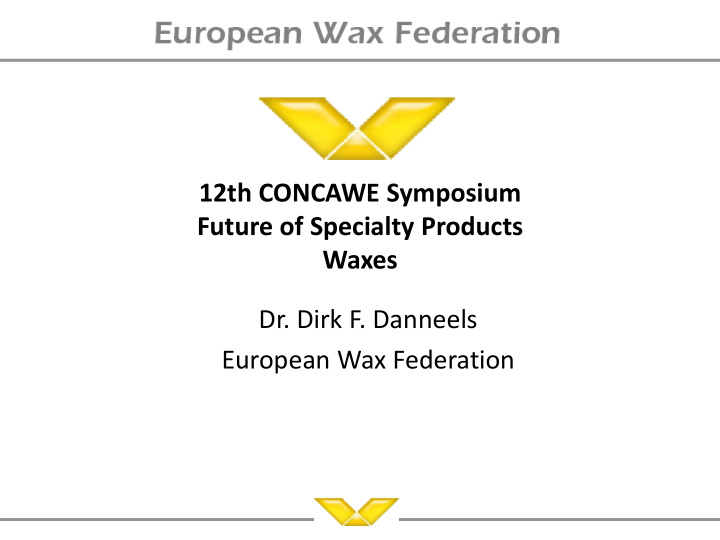



12th CONCAWE Symposium Future of Specialty Products Waxes Dr. Dirk F. Danneels European Wax Federation
Specialty Petroleum Substances • Side stream of lube oil production • Wax definition: – Solid at 20°C (soft and flexible to brittle and hard) – Melts above 40°C without decomposition – Low viscosity little above melting point • Complex supply chain including additional purification and blending steps • Tight quality specs imposed by regulators and customers – Food contact, pharmaceutical and cosmetics
Fractionation and Chemical Processing (simplified) Distillation Conversion / upgrading processes Approximate cut points indicated Subsequent distillation steps combined Hydrodesulfurization / others omitted Reformer Reformate Aromatics Atmospheric distillation Vacuum distillation Solvent extraction & others 0 Naphthas Aromatic extracts Main product type 450 Gas oils 85 Lubricants Gasoline 165 Waxes 550 Kerosine Crude oil Foots oils & Petrolatum 235 Distillate fuels Gas oils Bitumen / Asphalt Residual fuels 300 Hydrocracker Bitumen 350 Naphthas Others Gas oils Residue Residue Residue Catalytic cracker Alkylation Olefins Alkylate Naphthas Gas oils Residue Thermal cracker Naphthas Gas oils Residue Bitumen Residual fuels
Manufacturing Processes Specialty PS OTHER LUBRICANT BASE Solvent Dewaxing OILS Refining: Hydrogenation or Slack Wax Petrolatum Clay Treatment Foots Oils Petrolatum De-Oiling Paraffin and Hydrocarbon Waxes Refining: Hydrogenation or Clay Treatment Paraffin and Hydrocarbon Waxes
Comparison wax and Oil Chromatograms C 25 LMPW: Paraffine 52-54 White Mineral Oil P15 5x expanded 5 High Temperature GC
Functional Properties and Uses of MHC Waxes Etymology: Paraffin (n.) coined c. 1830 by German chemist Karl von Reichenbach (1788-1869), irregularly from Latin parum "not very, too little," probably related to parvus "little, small" (see parvi-) + affinis "associated with" (see affinity). • Important functional properties – Lubrication and release – Moisture barrier • Keeping moisture in – Cheese Wax, Fruit Coating • Keeping moisture out – Paper and Board Coating – Solid at room temperature, low viscosity when molten • Viscosity modification, hot melt adhesives – Very inert and non-allergenic materials • Non-food related uses – Candles (Fuel) – Rubber (Anti-ozonant) – Cable filler (Moisture protection)
Multiple Framework Challenge Inventory List Entries Commercial Specifications – CAS/EC numbers – Physical Properties – INCI names – Chemical Characteristics Regulatory purity criteria Substance Definitions – Pharmacopoeias – Chemical compositions – Food Additives – Regional differences in substance definitions – Food Contact Additives Need to comply with different, sometimes mutually incompatible requirements
EU Level Food Contact - Overview (EC) No. 1935/2004 Framework Regulation (EC) No. 2023/2006 Good Manufacturing Practice EC/ 450/2009 2007/42/EC EU 10/2011 Elastomers and 84/500/EEC Active & intelligent Regenerated Rubbers Ceramics Plastics materials Cellulose Film 93/11/EEC Nitrosamines Non-Harmonized Materials and Articles Paper & Metal and Ion-exchange Varnishes and Glass Waxes Wood Cork Textiles Adhesives Printing Inks Silicones Board Alloys Resins Coatings 8
Current Challenges • Regulatory Framework – Uncertainty on harmonized EU Food Contact Material rules • Cross-Sector Group Food Contact Materials • NGO Driven consumer concerns – MOSH/MOAH in food packaging and cosmetics • MOCRINIS 2 scheduled in October 2017
Recommend
More recommend